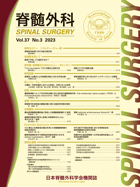Current issue
Displaying 1-17 of 17 articles from this issue
- |<
- <
- 1
- >
- >|
Vistas
-
2023 Volume 37 Issue 3 Pages 193-194
Published: 2023
Released on J-STAGE: January 09, 2024
Download PDF (184K)
Best Teacher Award
-
2023 Volume 37 Issue 3 Pages 195-200
Published: 2023
Released on J-STAGE: January 09, 2024
Download PDF (1362K)
Masters in Spinal Surgery
-
2023 Volume 37 Issue 3 Pages 201-205
Published: 2023
Released on J-STAGE: January 09, 2024
Download PDF (740K)
Reviews and Opinions
-
2023 Volume 37 Issue 3 Pages 206-213
Published: 2023
Released on J-STAGE: January 09, 2024
Download PDF (1923K) -
2023 Volume 37 Issue 3 Pages 214-220
Published: 2023
Released on J-STAGE: January 09, 2024
Download PDF (499K)
Review-Essentials
-
2023 Volume 37 Issue 3 Pages 221-226
Published: 2023
Released on J-STAGE: January 09, 2024
Download PDF (4668K) -
2023 Volume 37 Issue 3 Pages 227-231
Published: 2023
Released on J-STAGE: January 09, 2024
Download PDF (1755K)
Forum-Strategies & Indication
-
2023 Volume 37 Issue 3 Pages 232-250
Published: 2023
Released on J-STAGE: January 09, 2024
Download PDF (11933K)
Review Article
-
2023 Volume 37 Issue 3 Pages 251-258
Published: 2023
Released on J-STAGE: January 09, 2024
Download PDF (1247K)
Original Article
-
2023 Volume 37 Issue 3 Pages 259-263
Published: 2023
Released on J-STAGE: January 09, 2024
Download PDF (317K)
Case Reports
-
2023 Volume 37 Issue 3 Pages 264-271
Published: 2023
Released on J-STAGE: January 09, 2024
Download PDF (2337K) -
2023 Volume 37 Issue 3 Pages 272-277
Published: 2023
Released on J-STAGE: January 09, 2024
Download PDF (1569K) -
2023 Volume 37 Issue 3 Pages 278-283
Published: 2023
Released on J-STAGE: January 09, 2024
Download PDF (1393K)
Extended Abstracts
-
2023 Volume 37 Issue 3 Pages 284-286
Published: 2023
Released on J-STAGE: January 09, 2024
Download PDF (877K) -
2023 Volume 37 Issue 3 Pages 287-289
Published: 2023
Released on J-STAGE: January 09, 2024
Download PDF (490K) -
2023 Volume 37 Issue 3 Pages 290-291
Published: 2023
Released on J-STAGE: January 09, 2024
Download PDF (513K) -
2023 Volume 37 Issue 3 Pages 292-293
Published: 2023
Released on J-STAGE: January 09, 2024
Download PDF (282K)
- |<
- <
- 1
- >
- >|
